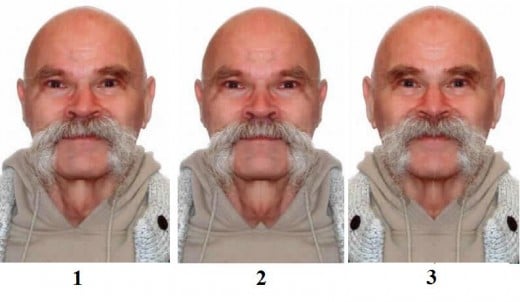Virtual People
One real and two virtual, which is which?

The State of A.I. (Artificial Intelligence)
Is is possible that some of your friends that you met on line do not really exist? Sadly this is very possible. Why sadly? In this age of censorship and misinformation, to add another curve in the control of the people, virtual people is a natural. The technology has been in place for some time in some areas. With modern animation techniques, it is getting harder to tell the difference between real and virtual. But the difference between a real person and a virtual one is the difference between flesh and bone and a sophisticated algorithm. All is not lost as there is always the unpredictable element in the natural that cannot be as yet achieved in the artificial. Let's look at the state of the art as far as virtual people are concerned. These exist in the public domain as well as the private psy-ops that are becoming more of the norm in the modern theatre of combat and civil control. No longer are we satisfied with simple deletion of people in photos. We like to manipulate photos and videos to drive home certain points. Comedy spoofs of politicians are a field where such activity runs rampant.
In the public domain, we are seeing the advent of sophisticated animated full length feature movies where there are no real actors. Even the voices are manufactured. Among the more realistic are features like the 300 and Beowulf (the most recent releases). Animation is also taking on a real 3D appearance, but the difference is that we can readily tell they are animations such as we see in Shrek, the Ice Age series and Happy Feet. These tricks are not just limited to the movies. They more often show up in sophisticated and expensive advertizing. We've all seen these ads as they inundate us from all angles. The new 3D craze in HDTV and LED HDTV formats lend themselves to this wide open field. It should come as no surprise that all of this has a dramatic impact on individuals and society. The electronic world is crammed with a myriad of 3D animated games with virtual people and animals. Some of us need to take a closer look at the video games our children are playing with. Some of these have already shown up on the social media, but many are obvious. What is being considered here is the virtual person that can pass as real, and there are reasons why virtual posers of the real may be used to direct your postings in a leading manner. The old adage thus applies; do you want your mother of boss to read particular social posts? Will what you say land you in dutch with the family or on the street after being fired. It has happened!
It was recently announced that Facebook hosts virtual people that do not exist in reality. They are a figment of someone's imagination, individual and/or corporate, and they are posted as real people complete with a history, photos and videos; hard to tell from the real thing. One or more of them may have solicited to be your friend and what's more, you may have give them the go ahead approval. When we find these virtual people seeking to be friends of ours, we have to ask, to what end? Is it a prank or is there something more sinister at work? Given the politic of the era, we have to consider the sinister as a distinct possibility.
For the right price, you can buy software that will manufacture virtual people and you can populate your own stories with them. It may well be the new form of combined novel and movie. However, the art has not finished evolving and for the looking, we can discern the fake from the real, at least from this point. Here are a few tricks to pick out the real from the phony.
Bilateral symmetry does not perfectly exist in the natural world and this can be easily proven. There is always some difference between the right and left halves of the face and body. Thus a simple test exists to sort the real from the virtual, for in most virtual representations, there is bilateral symmetry. What you need is a full face on photo to work this out. A profile or a three-quarters view will not work in this test. Thankfully, there is no shortage of a face on shot. Most driver's licenses, identification and passports require a full face photo. For the purposes of this exercise, ignore the clothing and concentrate on the face, neck and posture. Look at the three faces above. At first glance, they look pretty much the same, but on a detailed examination you can spot some differences from the left and right side composites in photos #2 and #3. The photo # 1 on the left is the original and the other two are mirror image composites of left sides and right sides. By careful examination, you can spot the differences and tell which is real and which is fake, which is made of left sides and which is if right sides. Virtual people have prefect symmetry like in photos #2 and #3 and do not have subtle left and right biases as in photo #1. However, getting a face on view of a virtual person may be something the programmer is aware of and so you will never see a face on photo. This in itself may be a good clue, especially if a lot of photos are posted. In most peoples profiles, you should be able to see at least a few photos where you can discern left-right asymmetry.
A virtual person exposed?
The second test is have you ever met the person for real. Try a meet up where possible to ascertain that the new friend is indeed real. When social media started, it was a way for real people to keep in contact like e-mail only better with photos and videos. Very quickly, as the popularity spread around the world, many people got contacts from many people around the world that they would not likely meet. So a wide field of potential virtual people opened up and into this breach entered the virtual person that was set loose to collect friends for the designs of the creator of these entities.
By now with the sophistication of psychology, we can mimic real behaviors and responses in the virtual and do this in near real time streaming. This is also being applied in the world of robotics where the “holy grail” is to create and android that can pass as fully human without being detected as being other than human. In the meantime, we have to be “satisfied” with the virtual person who has not manifested physically, but exists in that often heady world of the social media. In this milieu the virtual person can pass as real with seemingly all the quirks and glitches of real people. Each one can be tailor made so that no two are exactly alike within the constraints of the existing programming.
The third test is one of wit and nuances of language that are not necessarily based on logic. Even questions and statements can be formed that can befuddle and boggle the mind. These same nuances are the foundation of humor and comedy. To an ordinary human who has the same understanding, this is not a problem, but it can be for the totally logical virtual person. In the real world, we have real randomness. But in the virtual world, there is only the pseudo random. On casual inspection, these may look the same, but there is all the difference in the world. The nature of pseudo-randomness is such that when it run on the same sequence repeated times, the same seemingly random output is created every time. In the real world, this never occurs. For instance, a series of coin tosses in the real world will never have the same run twice let alone every time you run the series. In the virtual world, the coin toss is not real emulating randomness unless you take some manipulative and serious control, Control of an outcome of course, is not random at all but deliberation masquerading as random. Without complex manipulation, every series will be identical, which is why it is pseudo-random. The watchword here is of course, if you are into gambling, make sure its real and not virtual. In the virtual there are no ways where one can monitor the process with checks and balances. Back to the world of language nuances. We can say and understand conundrums like; “The following statement is the truth. The preceding statement is a lie”. Or there are statements like “To be impossibly perfect is perfectly impossible”. Stephen Hawking even did it when he said that knowing what is beyond an event horizon is like defining what life is like one mile north of the north pole. In a dialectical world, human beings have to deal with contradictions like this on an ongoing basis. In the virtual world, the script is written out beforehand in keeping with pseudo-random flow and cannot respond to sudden changes in direction of unpredicted ways. Though it is true, just as in many video games, that there can be numerous outcomes, still the number is limited by the constraints of available memory and RAM space. Each and every branch and potential outcome remains intact unless the program is corrupted by a glitch or virtual virus that usually renders it into gibberish.
Today it is likely that we all now have virtual friends who have no real substance beyond what we see and read on the computer screen, Ipad of Iphone. So when you are on the media, including likely this one, be conscious and careful of the potential of the virtual person. A virtual person just might cajole you into saying or doing something that you will later regret or that will come back to haunt you with a vengeance. There are tests, checks and balances and you should use them. Otherwise it's entirely possible that you may just fall in love with an algorithm. But just try to do something in the real world of flesh and blood with an mathematical construct.
How to train a virtual person prior to release
The effect of Virtual People in a Rasl World









